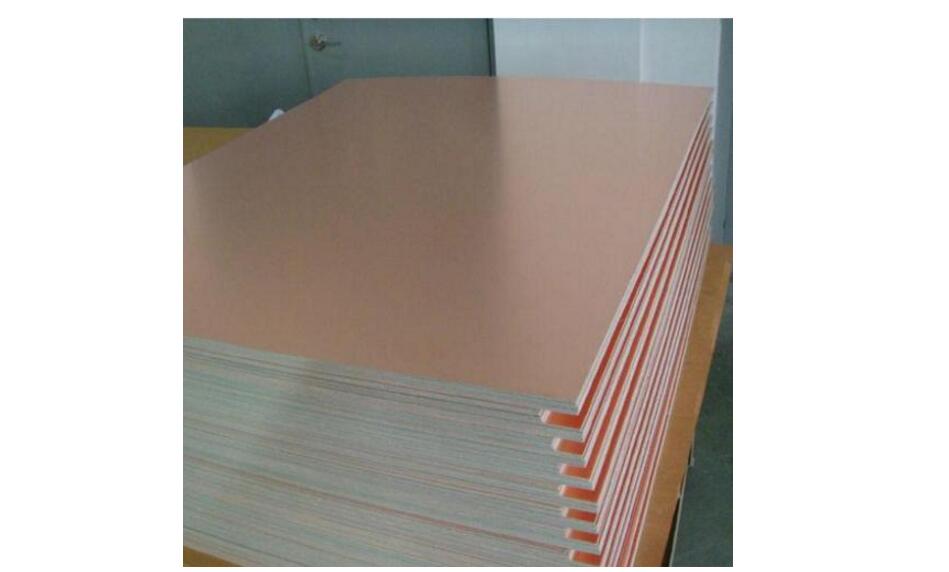Production process of glass fiber cloth-based copper clad laminate
(1) Manufacture of resin limb fluid
The production of resin glue is completed in the reactor. The manufacture of resin glue for paper-based copper clad laminates generally begins with the synthesis reaction of the original resin. After the original resin is made into the resin form of the A stage, other resins, additives, solvents, etc. are added to the reaction kettle for preparation, and finally a resin glue solution that can be directly glued is processed (overseas, it is called Fanli water) , ResInvarnish). The manufacture of its original resin is generally the manufacture of modified melamine resin. In this manufacturing process, the main control performance inspection items are: resin gelation time (also known as geltime, geltime), resin volatile content (volatilecontent), density, gradient, solid content, free content, etc. . Then the intermediate control or general process research determination of the resin manufacturing process, common items are: pH value, Mongolia degree, gelation time, refractive index, water number, turbidity, reaction rate, free content and so on.The manufacture of resin glue for epoxy-glass fiber cloth-based copper-clad laminates is mainly resin preparation and processing. The original resin (epoxy resin) provided by a professional resin production plant is put into the reaction kettle, and then the curing agent is added to promote curing Agents, other auxiliary agents, solvents, etc., mixed and dissolved to make.
In the process of resin synthesis reaction, the evaporation area (or diameter-to-height ratio) of the reactor in the design and selection of equipment, the pumping rate of the vacuum pump, the condensation area of the condenser, the temperature of the condensed water, the reactor jacket The method of heating and cooling, the effect of the agitator of the reactor, etc., have an important influence on the performance of the synthetic resin. The correct and reasonable control of the temperature, vacuum and reaction time of each reaction stage in manufacturing is also very important. For resin formulation and processing, it is necessary to strictly control the dosage of each component and the time and temperature of the mixing and dissolution reaction.

(2) Impregnation and drying of semi-finished products
Inject the manufactured resin glue into the glue tank of the glue machine, using fiber paper, fiberglass cloth, fiberglass paper, etc. as the reinforcing substrate, impregnate the resin glue, and then go through the oven of the glue machine at 120 Heat and dry at ~180°C to make the resin in a semi-cured state (stage B resin), and remove the solvent. This process is called gluing, and its products are called gluing paper (or gluing cloth). As an important raw material for the manufacture of multi-layer boards, the adhesive tape is also called prepreg (PP for short, or preimpregnated bonding sheet).The gluing paper processing of the paper-based copper clad laminate is generally carried out in a horizontal gluing machine. The processing of gluing the fiberglass cloth-based copper-clad board is generally carried out in a vertical gluing machine. The quality control indicators of glued paper (glued cloth) generally include resin content (resincontent, RC%), resin flowability (resinflow, RF%), volatile content (volatilecontent, VC%), and resin gelation time (geltime, GT), in addition to the quality control indicators of gummed paper, there are also sheet quality and soluble resin content. Some manufacturers also do research and test on the quality performance of the upper tape, such as the melting Mongolia degree curve, the hydrogen peroxide adhesive crystallization test, the curing percentage, and the proportional fluidity.
In the sizing process, the semi-finished sizing paper (cloth) is completed by the gluing machine through two major processes: impregnation and drying. The impregnation process is essentially a process in which the impregnated resin glue and the air in the fiber structure of the reinforcing substrate are exchanged with each other. During the impregnation process, the resin glue of appropriate molecular weight, degree and temperature passes through the primer coating of the sizing machine (one-way immersion of the resin), extrusion series <two-way immersion of the resin, control of the uniformity and resin content of the dipping) The mechanical effect of the system will remove the air in the fiber of the reinforcing substrate, so that the resin glue will occupy its space and reach a certain thickness of the coating. Therefore, ensuring the uniformity and resin occupancy rate of the impregnated fiber space are the two important objectives achieved in the impregnation and drying process of semi-finished products.
Gluing processing is an important key processing procedure to ensure the quality level of prepreg and copper clad laminate products. Achieving a certain uniform glue content is guaranteed by the form of the glue machine, the number of dipping times, the speed of glue application, the size and accuracy of the gap between the squeezing spokes, and the operating quality of other attachments. The permeability of the sizing paper (cloth), that is, the ability and uniformity of the impregnated fiber material to absorb the resin glue depends on the nature of the resin glue absorbed (molecular weight, degree, density, solid amount, etc.), At the same time, it is also related to the immersion method, ambient temperature, gluing speed, and glue circulation.
Wet gumming paper <cloth) after impregnation, drying in the oven of the gumming machine needs to complete two necessary processes:One is the evaporation process of low-molecular volatiles (including solvent) in the solvent and resin; the second is the polycondensation process of the resin molecule to a certain extent. The former is the process of physical change, the latter is the process of chemical change. After the drying process is completed, only a small amount of volatile components remain in the gummed paper (cloth) and a certain degree of soluble resin flow that is compatible with the lamination molding process.
The process of drying is the process of the mutual conversion of the heat transfer of the heat carrier and the mass transfer of the wet carrier, and also the process of converting the resin structure of the glue paper (cloth) from the A stage to the B stage. With the deepening of heating and drying, a certain polycondensation reaction occurs on the resin of the gummed paper (cloth), and the cross-linking density and molecular weight are continuously increasing. When the drying is completed, the components of the A and B stage resins that can be dissolved in some organic solvents are generally reduced to 75% to 95%. Strictly grasping the degree of curing and conversion of the resin is a very important process control work in the sizing process. During the drying of the sizing, the molecular weight distribution structure of the impregnating resin also changed.
Relevant Japanese experts used gel permeation chromatography (GPC) technology to divide the epoxy-hydrogen peroxide resin system of FR-4 prepreg before and after drying into three areas according to different molecular diameters, to measure and statistics (Figure 2-5 , Table 2-11). The test results show that after processing the resin, the mass percentage of the resin in the low molecular weight (can be regarded as a monomer) portion and the medium molecular weight portion are reduced. Among them, the decrease range of the low molecular weight region is larger than that of the middle molecular weight region, and the resin mass percentage of the high molecular weight portion increases. The increase is between 6% and 7%. The dispersion coefficient (Mw/Mn) of the entire resin does not change much.
(3) Lamination molding process
The entire stage of the lamination process of copper clad laminates mainly includes cutting, layup, and lamination of the adhesive tape (the adhesive paper is cut at the same time during the adhesive processing) , Unloading board and other major processes.
Use the prepared semi-finished laminated paper (cloth) laminated blank, covered with copper anchors, put the copper plate up and down as a mold, and then placed between the heating plates of the press for high temperature and high pressure lamination processing. The lamination process is completed through three different process control stages: pre-heating, hot pressing and cooling. At present, due to the improvement of production technology (the quality and performance of resin production and gluing processing) of paper-based copper-clad laminate lamination processing, most manufacturers at home and abroad can achieve direct high-temperature, high-pressure lamination process. In the process of lamination, the fiberglass cloth-based copper-clad laminate generally adopts the "two-step method" to improve the performance of the laminate. That is, the pre-heating stage of pressing is carried out at a lower temperature and a lower pressure, and then the high pressure and the temperature are increased to complete the curing and molding of the board.The lamination molding process on the hot press is to make the resin of the sizing paper (cloth) first in the gap of the fiber-reinforced substrate for a short time of melt re-infiltration (this kind of melt infiltration, which was used in the sizing process) The melt flow has been carried out at the beginning of the drying process). Then, the B-stage branched structure of the resin, after a period of heating reaction, transitions to the C-stage macromolecular network structure, completes the curing molding, and makes the remelted infiltration and curing molding of the finished product that meets the performance requirements of various aspects . Therefore, in the lamination molding process, the above two objectives of remelt infiltration and solidification molding are to be achieved.
The former is mainly completed in the pre-heating stage. This stage is based on the flow of resin, infiltration and penetration, the change of Mongolian degree in melting, the transition from the thick to the elastic, etc., to determine and grasp the high pressure from the pre-heating stage The "process window" transformed at the high-temperature lamination stage. The lamination molding process enters the high-pressure high-temperature lamination stage, mainly to complete the final molding process to complete the complete curing of the board.

